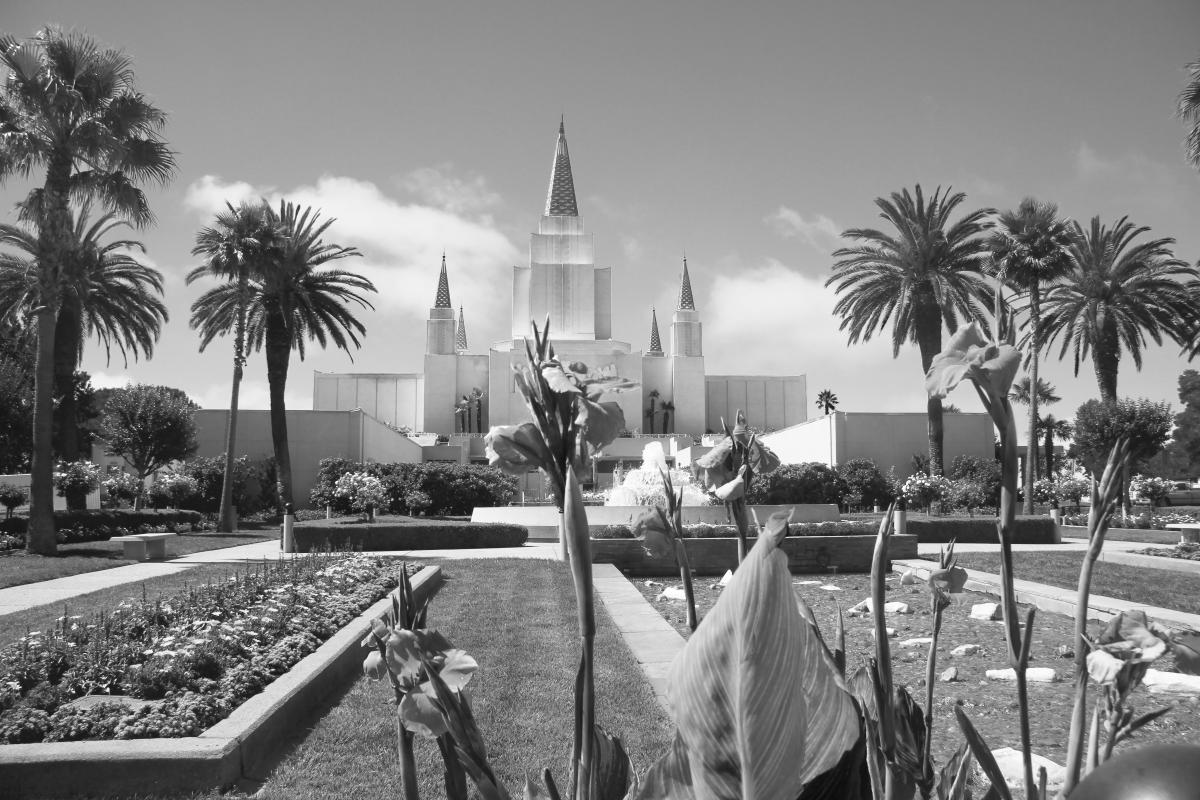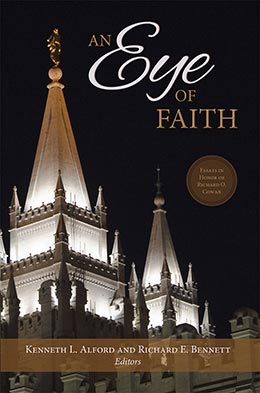Introduction
 The Oakland California Temple. (Photo by Brent R. Nordgren.)
The Oakland California Temple. (Photo by Brent R. Nordgren.)
Festschrift, a German word, literally means “celebration writing.” A centuries old academic tradition, a Festschrift is “a collection of writings published in honor of a scholar.” This volume of original essays is a Festschrift prepared in honor of Dr. Richard O. Cowan, recently retired professor of Church history and doctrine at Brigham Young University. Brother Cowan, as he is affectionately known to most of his former students, served at BYU for more than half a century teaching, researching, writing, mentoring, and befriending all who crossed his path. It has been estimated that he personally taught over 40,000 students during his academic career. And did we mention that Dr. Cowan did it all while being unable to see with his physical eyes? Yes, he is blind. But Richard Cowan has clear vision in the things of God. Hence the title of this book, “An Eye of Faith.”
This volume appropriately begins with an interview with Richard O. Cowan by Lloyd D. Newell and concludes with a chronological bibliography of his many publications; a timeline of his life is also included. Dr. Cowan has a deep and abiding interest in temple work and has written prolifically and wonderfully about this important subject. In over five decades of scholarly writing, he has also published a wide variety of books, essays, and articles about modern-day revelation, service and missionary work, increasing scriptural literacy, and the Restoration of the gospel of Jesus Christ. The essays in this volume have been organized likewise, and each essay begins with a personal reflection from the author regarding their associations with Richard O. Cowan. We should also note that there were several additional authors who also wished to contribute essays in his honor, but this volume was unable to include all of them. The first section in this volume, “Temples: Ancient and Modern,” begins with an essay by Terry B. Ball discussing Isaiah’s prophetic insights into temple building and temple worship. Next Craig K. Manscill explains several recent discoveries regarding the significant role that Hyrum Smith played in building the Kirtland Temple. Ann N. Madsen compares and contrasts ancient and modern temples as she looks at Solomon’s Temple and the Salt Lake Temple. The last essay in this section, by Alonzo L. Gaskill and Seth G. Soha, searches for the meaning and purpose of an unusual statue that has been mounted over the veil in the Salt Lake Temple’s celestial room since the temple was dedicated.
The second section, “Revelations to the Saints,” opens with two complementary essays investigating the doctrine and practice of baptism for the dead in the mid-nineteenth century. Alexander L. Baugh reports on the introduction of baptisms for the dead in Nauvoo, Illinois, while Richard E. Bennett’s essay picks up that narrative and expounds on the practice of baptism for the dead from 1846 through 1875. Craig J. Ostler explores the meaning of Moroni’s 1823 statement to Joseph Smith regarding “the promises made to the fathers,” and Christopher J. Blythe examines a vision that Heber C. Kimball and Orson Hyde received in 1837 at the beginning of missionary work in England.
“Serving Others and Sharing the Gospel,” the following section, begins with Susan Easton Black’s account regarding the 1970s creation of the Monument to Women Memorial Garden in Nauvoo, Illinois. Kenneth L. Alford shares little-known stories regarding acts of personal service and kindness rendered by each of the prophets of this dispensation from Joseph Smith Jr. to Thomas S. Monson. Nicholas J. Frederick analyzes early missionary outreach efforts by Joseph Smith and Parley P. Pratt. In the final essay in this section, Elise Petersen and Steven C. Harper investigate how collective memory and mass media have played a role in the Church’s understanding and use of Joseph Smith’s First Vision.
The fourth section, “Increasing Scriptural Understanding,” includes three scripturally based essays. Richard D. Draper carefully outlines the Lord’s doctrine in the scriptures regarding sexual purity. Kent P. Jackson scrutinizes the King James translators’ use of the word “replenished” in the Bible. In the concluding essay in this section, Kent S. Brown weaves a missionary narrative with a moral for our time from Helaman chapters 4 and 5.
“A Mighty Work to Come Forth,” the final section in this volume, begins with a nostalgic half-century look back by Brent L. Top to the popular Mormon Pavilion at the 1964–65 World’s Fair held in New York City—arguably one of the first times that the Church appeared prominently on a world stage. JeanMarie Stewart and Kenneth L. Alford trace the history regarding the establishment of the gospel in the African nation of Ghana. And in the final essay, J. B. Haws explores more recent history as he discusses the roles that the Church played, as well as those it consciously did not play, during Salt Lake City’s hosting of the 2002 Winter Olympic Games.
We appreciate this opportunity to honor our great colleague, Richard O. Cowan, and hope you enjoy this volume!
Kenneth L. Alford
Richard E. Bennett
Editors
Key Events in the Life of Richard O. Cowan
DATE | EVENT |
| January 18, 1932 | Dawn Sandra Houghton born in Oakland, California |
| January 24, 1934 | Richard O. Cowan born in Los Angeles, California |
| December 3, 1935 | Richard’s Sister Jean Isabelle Cowan born in Los Angeles, California |
| April 4, 1942 | Baptized in the Wilshire Ward Chapel, Los Angeles, California |
| November 1, 1949 | Received patriarchal blessing at age fifteen from Orson Haynie |
| February 1, 1952 | Received a priesthood blessing from President David O McKay |
| Summer 1952 and Summer 1953 | Called to serve in the Los Angeles Stake Mission, Spanish-speaking |
| February 21, 1953 | Ordained to the office of elder by his father |
| June 23, 1953 | Received mission call to the Spanish-American Mission |
| August 9, 1953 | Missionary farewell in the Arlington Ward |
| August 19, 1953 | Entered the Missionary Home |
| August 26, 1953 | Set apart as a missionary by Elder S. Dilworth Young, First Council of the Seventy |
| March 8, 1955 | Dawn received her mission call to the Spanish-American Mission |
| Summer 1955 | Met Dawn in the Spanish-American Mission in Texas. |
| February 1956 | Released from full-time missionary work |
| April 28, 1957 | Dawn was released from full-time missionary work |
| November 19, 1957 | Elected to Phi Beta Kappa |
| April 1958 | Engaged to Dawn Houghton |
| April 1958 | Awarded the Danforth Fellowship |
| June 14–15, 1958 | Graduated from Occidental College |
| August 14, 1958 | Married Dawn in the Los Angeles Temple |
| May 8, 1959 | Notified that he would receive a Recordings for the Blind scholarship |
| May 19, 1959 | Recordings for the Blind scholarship presented by President Dwight D. Eisenhower |
| June 14, 1959 | Received master’s degree from Stanford University |
| June 10, 1960 | Daughter Sandra Lynn born in Redwood City, California |
| January 25, 1961 | Joined full-time religion faculty at Brigham Young University |
| August 11, 1961 | Received PhD from Stanford University |
| August 29, 1961 | Moved to Provo, Utah |
| September 20, 1961 | Began first year of teaching at Brigham Young University |
| July 13, 1962 | Daughter Linda Dawn Cowan born in Provo, Utah |
| June 11–14, 1962 | Taught at BYU Campus Education Week for first time |
| July 27, 1963–June 1965 | Served as an elders quorum president |
| August 2, 1964 | Son Reed Richard Cowan born in Provo, Utah |
| July 10, 1964 | Published his first book |
| June 24, 1965 | Ordained a high priest |
| June 24, 1965–1967 | Call to serve on the BYU 6th Stake High Council |
| May 13, 1965 | BYU “Professor of the Year” |
| March 20, 1967 | Son Lee Richard Cowan born in Provo, Utah |
| April 28, 1967 | Served as counselor in BYU 6th Stake Presidency |
| November 25, 1970 | Contributor to Gospel Doctrine teachers manual |
| September 26, 1971 | Daughter Patricia Ann Cowan born in Provo, Utah |
| April 30, 1972 | Released as a counselor in the BYU 6th Stake Presidency |
| February 1973 | Called to serve on the Church blind programs advisory committee |
| August 22, 1973 | Assigned to be the Doctrine and Covenants coordinator at BYU |
| November 1973 | Member of the Church Melchizedek Priesthood Research Committee |
| November 4, 1975 | Served on the Church Gospel Doctrine committee |
| December 20, 1976 | Daughter Donna Jean Cowan born in Provo, Utah |
| May 1, 1976–1979 | Served on the Mormon History Association executive council |
| 1977 | Taught noon Spanish class for faculty colleagues |
| 1977 | Produced Church history television modules |
| 1979 | Received the Karl G. Maeser Excellence in Teaching Award |
| December 18, 1979 | Called to serve as the Missionary Training Center historian |
| September 1980–June 30, 1993 | Church Gospel Doctrine Manual Writing committee chairman |
| 1981 | Member of university rank advancement committee |
| October 21, 1992 | Served on Faculty Advisory Committee |
| 1983 | Joined Church Education System Church History text committee |
| November 12, 1983 | Continuing Education Outstanding Teacher Award |
| July 8, 1986–2008 | Member of Provo East Stake High Council |
| August 21, 1989–1993 | Religious Studies Center Doctrine and Covenants director |
| Fall 1989 | Taught at the BYU Jerusalem Center |
| April 13, 1994–1997 | Chair, Church History and Doctrine Department, BYU |
| July 24, 1996 | Directed faculty study tour to California |
| September 2000 | Concluding speaker at Sidney B. Sperry Symposium |
| November 20, 2003 | Gave annual Phi Kappa Phi lecture |
| Fall 2006 | Church History area coordinator |
| 2006 | Chair of Religious Education rank and status committee |
| April 3, 2007 | Gave devotional assembly address in the Marriott Center |
| Spring Term 2007 | Taught spring term at BYU–Hawaii |
| January 27, 2008 | Ordained a stake patriarch |
| March 22, 2008 | Received the Robert J. Matthews Excellence in Teaching Award |
| August 14, 2008 | Fiftieth wedding anniversary |
| 2011 | Completed fifty years in Religious Education as a faculty member |
| 2014 | Retired after teaching fifty-three years as a full-time faculty member at Brigham Young University |
